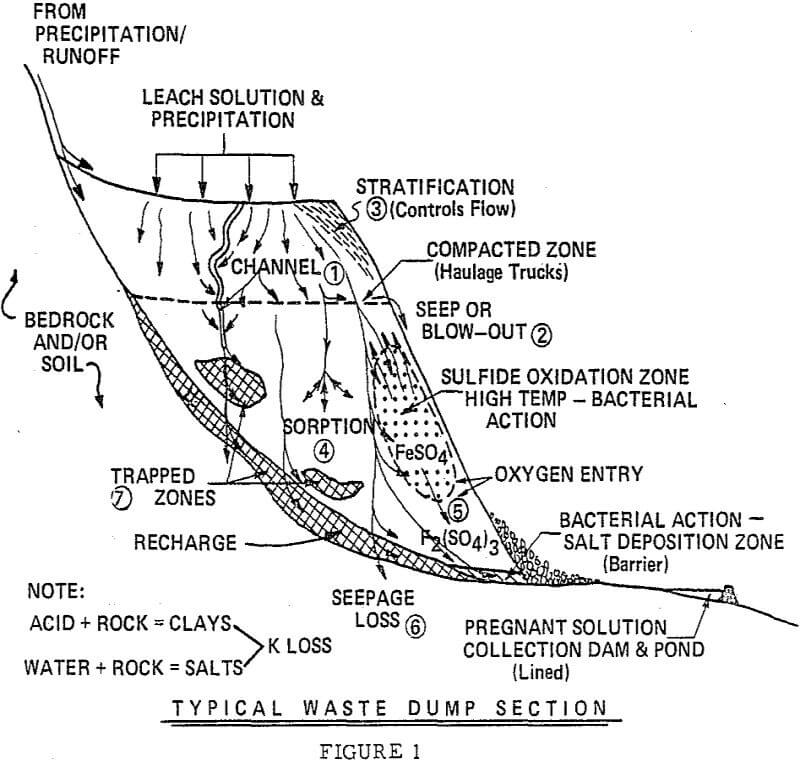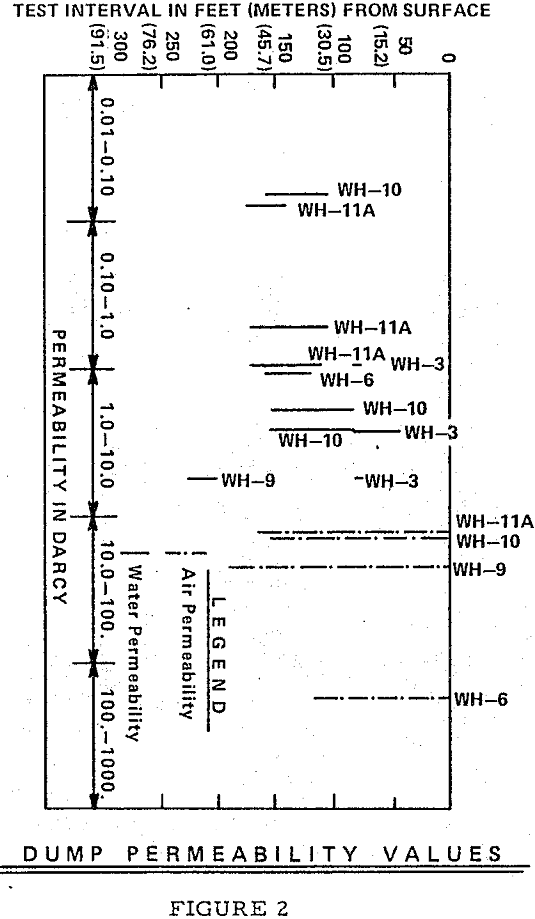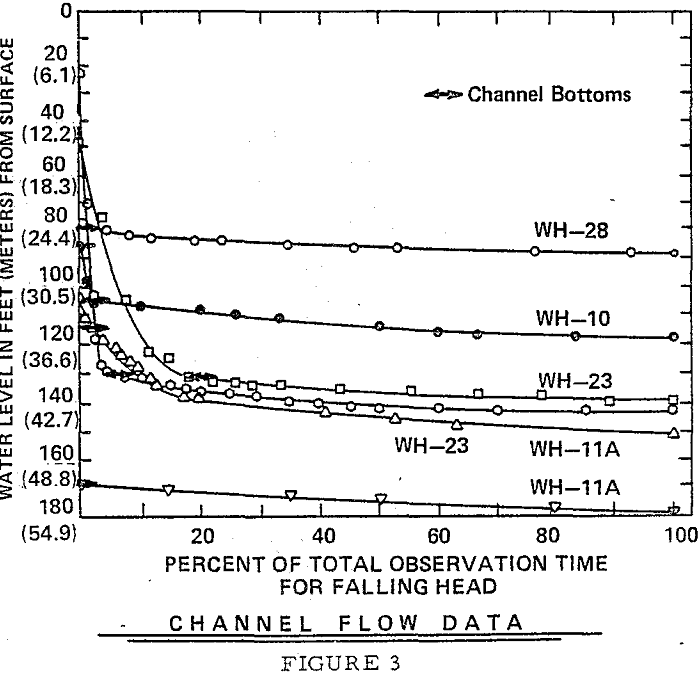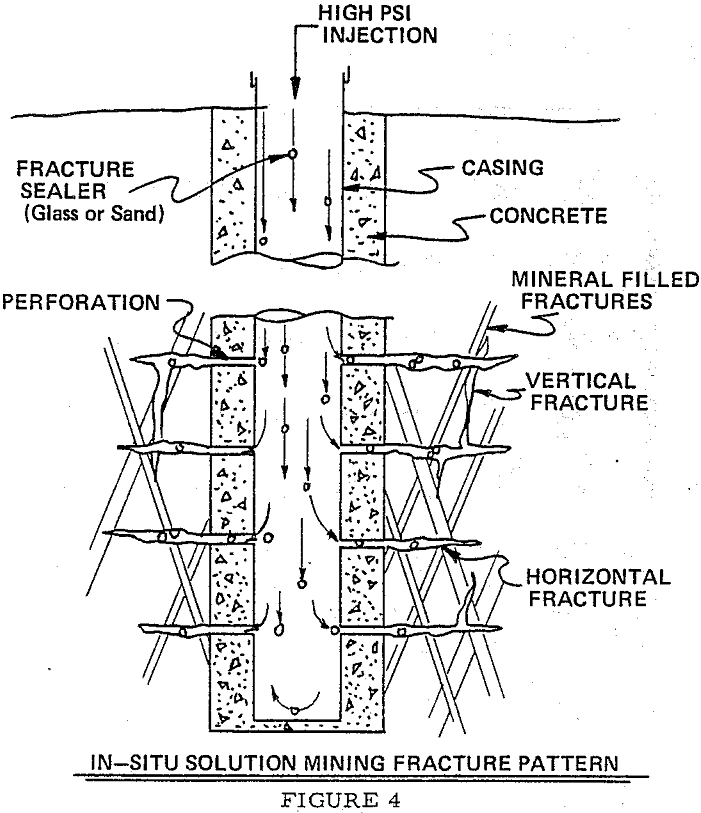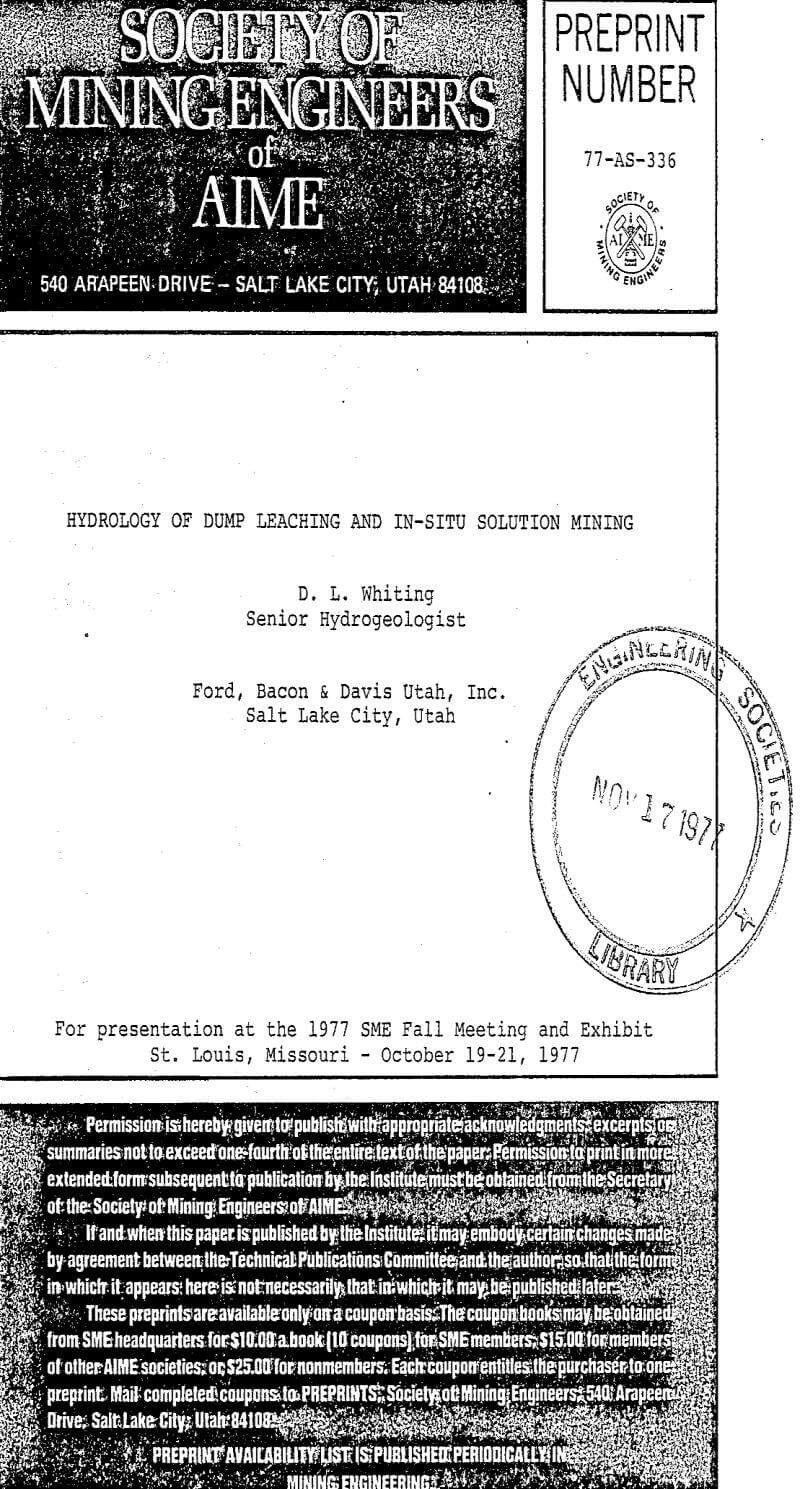Table of Contents
Dump leaching and in-situ solution mining have received considerable attention during the past few years due to their apparent economic viability and minimal environmental impact. Solution mining actually dates back to the 17th century when leaching of copper ore was first reported. However, modern day leaching didn’t begin on a wide scale until the mid-1900’s. In-situ mining for copper, nickel, salts, and oil shale is currently looking more attractive as the technology advances.
Hydrology of Dump Leaching
To assist in understanding the various factors which affect the hydrology of dump leaching, a basic understanding of a typical leaching system should be reached. In general, a dump leaching system used for extraction of copper consists of a mineralized waste dump usually containing rock too low in grade to extract; a leach solution application system suitable to the rock/ore type and dump construction; and a recovery system capable of capturing the maximum solution flow.
The several factors which are known to affect the hydrology of dump leaching can be divided into three main categories as follows:

Five main solution application techniques are used through the copper and evaporite industry today. They are:
- Pond – irrigation
- Trickle
- Multi-low pressure spray
- Single high pressure spray
- Well injection
Pond irrigation is the most widely used technique and consists of flooding by irrigating or by a peripheral spigot discharge system. A series of dikes are constructed on the top of the dump to contain the leach solution. To rejuvenate flow within the dump when recoveries begin to decrease, pond surfaces are scraped and ripped with a dozer.
Trickle leach application is a relatively new technique which is used primarily to extract copper sulfides from fresh dumps and those exhibiting high permeabilities. The more gradual application of solutions by the trickle system tends to avoid the quick breakdown of rock and mineral particles, thus enabling the solutions and air to flow through at a more uniform rate.
Spray solution application techniques have been employed with varying degrees of success. Even though spraying provides a uniform means of material contact, excessive solution losses to evaporation and high maintenance of sprinkler heads are the major problems.
The practice of injecting leach solutions into dumps using well bore techniques is not generally used in the copper industry. Utilization of injection techniques is, however, used quite extensively in the in-situ uranium, potash and salt industries.
Dump Flow Factors Affecting Recovery
Permeability – The permeability of a waste dump can be defined as the measure or the ability of liquid or gas to flow through the dump.
When determining dump flow, the permeability of discrete rock particles (less than darcies) cannot be ignored. Even though rock permeability does not affect waste dump flow, this permeability determines lixiviant penetration, which affects total waste leaching capability.
Solution Flow – The most important aspects of the hydrology of dump leaching are the physical and chemical factors influencing solution flow. Those factors are discussed as follows:
- Application Methods – Leach solution application methods can vary, as explained earlier in the paper, from trickle and spray to pond flooding.
- Lixiviant Chemistry – The hydrolysis and precipitation of iron salts reduces the surface permeability of the dumps which causes ponding of leached solutions and leads to channeling. When availability of pyrite and oxygen is not sufficient to produce adequate amounts of acid, then acid addition may be necessary to prevent precipitation of ferric salts.
- Sorption – The total effects of adsorption and absorption of rock and mineral particles in the dump media is considered its sorptive capacity.
- Foundation Conditions – The characteristics of the underlying dump foundation is important when determining solution loss and dump stability. The foundation, being either unconsolidated soil and/or consolidated rock would have naturally different values of permeability and other hydrologic features.
Dump Failures Resulting from Flow Problems
Dump failures often occur due to physical conditions within the dump and from surface and foundation conditions accompanying dump construction. A description of the different types of dump failures and their relationship to leach solution flow is as follows:
Blow-Out – A blow-out is a result of a sudden release of-water, usually within the upper dump face as a result of a build-up of fluid along a compacted zone or area of pronounced stratification. Typically, a blow-out will occur in a relatively short period of time following the introduction of leach solution to a dump where downward solution flow is impeded by a barrier or is permitted to accumulate by strata patterns or channeling near the dump face.
Slope Erosion – Seepage – Erosion of dump slopes by natural precipitation runoff can cause dump disfigurement or establish weak points where future failures can occur. Unfortunately, very little can be done to prevent slope erosion from runoff of active dumps and efforts to vegetate or terrace the faces of inactive dumps would fail due to the presence of unsuitable growth factors, highly unconsolidated material, and constantly changing surface conditions.
Foundation Slope Failures – Failures of the foundation are more likely if unconsolidated soils exist beneath the dump. Overtaxing the stress shear point is the most common reason for failure. Compression and movement of silts and clays is another failure cause.
Hydrology of In-Situ Solution Mining
Although in-situ leaching of copper deposits has been reported as being practiced back in the 15th century, the technique is little used today in comparison to dump leaching or conventional mining methods. However, recent environmental concerns resulting from conventional open pit and underground mining techniques and technology improvements has made in-situ mining more attractive. Recent advancements in technology, some borrowed from the petroleum industry, are making several low-grade or inaccessible mineral deposits more viable. In actuality in-situ leaching has been occurring naturally since the deposits were formed millions of years ago. Oxidation of the sulfide minerals first occurred when migrating groundwaters made contact.
Basically, the technology development essential to the future of in-situ solution mining is centered around the sciences of geology, hydrology, mineralogy, chemistry, and hydraulics. Other factors such as artificial fracturing and stimulation, economic viability and environmental compatibility are also important and must be understood. The successful advancement of in-situ solution mining is dependent upon understanding these factors and other parameters un-covered during long-term mining operations.
To increase and sustain fracture flow within the ore zone, it is usually necessary to artificially induce fracturing through well bore and/or fracture plane techniques. Three methods being experimented with which seem to have the most reliable results are discussed below:
Hydrofracturing – The injection of water under high pressure through a perforated well casing appears to be the most efficient technique where suitable conditions prevail.
Oxyfracturing – Liquid oxygen injected into the previously hydraulically fractured zone serves to accomplish three main purposes: (1) increase the fracture pattern due to the expansion as a result of the change from a liquid to a gaseous state; (2) increase the availability of water soluble copper salts; and (3) increase the solution acidity by the oxidation of sulfides in the formation.
Slurry/Liquid Explosives – Explosives are utilized for somewhat the same purposes as the hydrofracturing technique. Even though fracturing generally occurs, the patterns are not as easy to control or define.
The tendency for expanded fractures to collapse or become filled is the single largest factor to overcome when developing a fracture pattern set. Since collapse or filling occurs shortly after expansion, a propping agent must be injected into the opened fractures immediately.
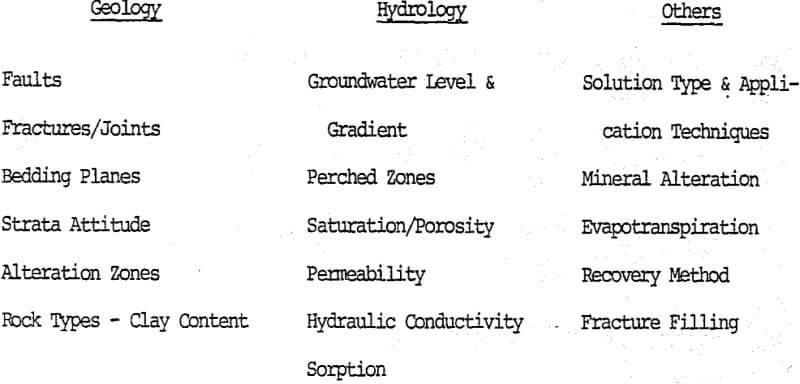
Recovery Flow Patterns
The flow patterns of solutions being recovered by pumping wells influence is essential to the prediction of system efficiency and design of future or improvement of existing in-situ leaching systems. To determine the recovery flow pattern, theoretical values are used based on hydrologic data and well hydraulics. Flow rates would increase even more if the recovery well were also fractured. Flow rate through a well system can be increased many times by well stimulation — as much as three to five fold.
Federal regulations for control of groundwater contamination from deep well injection were initially proposed under the authority of the Safe Drinking Water Act (SDWA) on August 21, 1976. The controls call for identification of lixiviant chemistry, maps of the project site showing all surface facilities, identification of local private water wells and gas/oil wells, in-situ well hydraulics, aquifer(s) definition, mineral resource description, geologic and hydrologic data, potentiometric maps, volume rate and injection pressure of the fluids and several additional facts concerning physical features of the site, both surface and subsurface.
